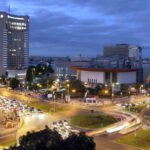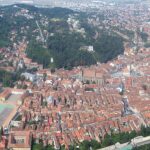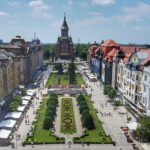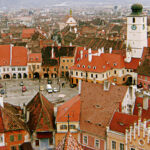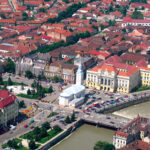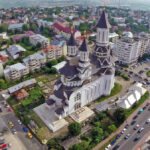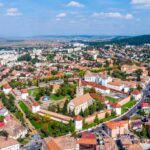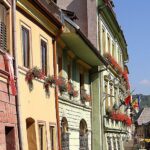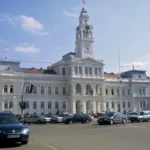Sinaia
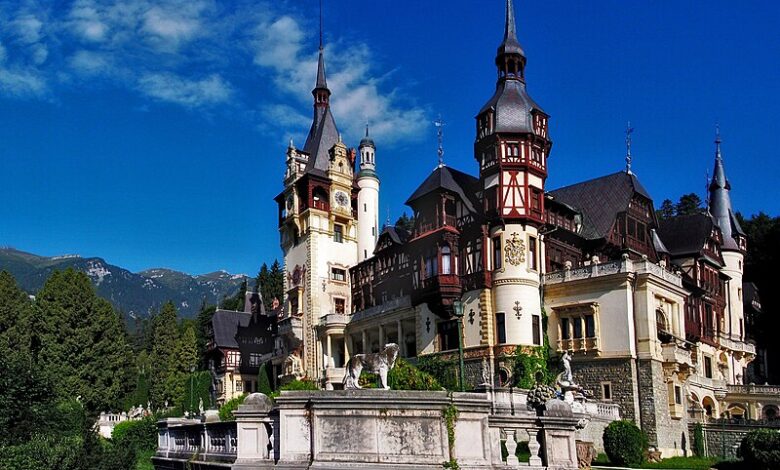
Sinaia is one of Romania’s finest holiday resorts, deep into the Carpathian Mountains. In the late 19th century, King Charles I of Romania chose Sinaia as his summer residence and built the fabulous Peles Castle, which is today the city’s best-known landmark.
Getting to Sinaia is made easy by train since it is on the main line between Bucharest and Brasov. All trains that go to Hungary pass Sinaia, as do those that service Oradea, Braşov and Cluj-Napoca. There are also many trains to and from Sighisoara, Timişoara, Iaşi and Arad. Sinaia is also accessible by intercity coach from Braşov, but the train is the better option.
| ID |
|---|
| 96350 |
| Name |
| Sinaia |
| State ID |
| 4729 |
| State Code |
| PH |
| State Name |
| Prahova County |
| Country ID |
| 181 |
| Country Code |
| RO |
| Country Name |
| Romania |
| Latitude |
| 45.35000000 |
| Longitude |
| 25.55000000 |
| WikiData ID |
| Q16898486 |
Sinaia (Romanian pronunciation: [siˈnaja]) is a town and a mountain resort in Prahova County, Romania. It is situated in the historical region of Muntenia. The town was named after the Sinaia Monastery of 1695, around which it was built. The monastery, in turn, is named after the Biblical Mount Sinai. King Carol I of Romania also built his summer residence, Peleș Castle, in Sinaia in the late nineteenth century.
Sinaia is about 65 kilometres (40 miles) northwest of Ploiești and 48 kilometres (30 miles) south of Brașov, in a mountainous area on the Prahova River valley, just east of the Bucegi Mountains. The town's altitude varies between 767 to 860 metres (2,516 to 2,822 feet) above sea level.
The city is a popular destination for hiking and winter sports, especially downhill skiing. Among the tourist landmarks, the most important are Peleș Castle, Pelișor Castle, Sinaia Monastery, Sinaia Casino, Sinaia train station, and the Franz Joseph and Saint Anne Cliffs. Sinaia was also the summer residence of the Romanian composer George Enescu, who stayed at the Luminiș villa.
Climate
Sinaia has a warm-summer humid continental climate (Dfb in the Köppen climate classification).
Summers are bracing and very rainy at the beginning of the season. Winters are moderately cold, with heavy snow.
A uniform layer of snow is deposited usually in November and it melts from March to April, sometimes at the beginning of May. The thickness of the snow layer varies between 20 centimeters (7.9 in) and 3 meters (9.8 ft) in higher elevations.
In recent years, Sinaia has felt the effects of global climate change.
Nature preservation
In the town of Sinaia and its surroundings restrictions are in place regarding cutting down or picking flora. The felling of trees is not allowed. It is forbidden to pick any alpine plants. Severe punishments are enforced for anyone who gathers : the Mountain Peony (Rhododendron Kotsky), Edelweiss (Leontopodium alpinum), and the Yellow Gentiana (Gentiana lutea). Tourist camping is only authorized in designated places, following necessary and compulsory protection standards.
The mountainous area in which Sinaia is located is in the Bucegi Natural Park region. The Park covers a total area of 326.63 square kilometres (126.11 sq mi), of which 58.05 km2 (22.41 sq mi) are under strict protection and contain natural monuments. The Bucegi Natural Preserve area includes all the most precipitous areas of the mountains Vârful cu Dor, Furnica, and Piatra Arsă. The mountainous area is continuously patrolled by mountain rescue patrols as well as by members of the Mountain Police.
At the entrance to the Cumpătu district, one can find the “Sinaia alder-tree grove” botanical reservation placed under the protection of the Romanian Academy and the Bucharest Biology Institute. In the same district, there is also another ecological research station under the patronage of UNESCO – Jacques-Yves Cousteau, belonging to the University of Bucharest, which also includes a museum of Bucegi Mountains fauna.
Tourist attractions
- Peleș Castle
- Pelișor Castle
- Sinaia Monastery
- Sinaia Casino International Conference Center
- Carmen Sylva Cultural Center
- George Enescu Memorial House
- Dimitrie Ghica park and the Bucegi Reserve Museum
- Heroes Cemetery
- Eagles of Freedom Plaza
- Franz Joseph and Saint Anne Cliffs
- Old electrical power plant
- Sinaia railway station
- Many other old villas
- Bucegi Mountains with a cable car connecting the resort with Cota 1,400 and Cota 2,000
- Baiu Mountains
- 16 ski slopes
- 4 mountain-bike trails
Sinaia Forever Festival
Sinaia Forever, or the Autumn Festival, is one of the main festivals that takes place in Sinaia. The goal of the festival is to recreate the atmosphere of the 1940s while bringing in modern performers. The festival once took place during the last weekend of September, but was just recently changed to the first weekend of the month. During the festival, the downtown area of Sinaia is closed off to motorized vehicles. It becomes full of people, food stands, and children's rides. The three-day festival consists of the opening parade, concerts from well known musical artists of Romania, and amusement rides.
Eagles of Freedom Plaza
The Eagles of Freedom Plaza (Romanian: Piațeta „Vulturii Libertății”) is a square inaugurated in 2015, dedicated to honoring the memory of 378 American soldiers who lost their lives in Romania during World War II. At the heart of the plaza stands the Book of Americans, a marble monument inscribed with the names of these fallen soldiers. Originally created in 1999, the monument was previously located on the outskirts of the Heroes Cemetery but has since been relocated to this new, more prominent site. A commemorative plaque is also present, honoring the heroic sacrifice of the American soldiers and celebrating the historic bonds of friendship between the Romanian and American people. The inauguration of the plaza was attended by Sinaia's Mayor, Vlad Oprea, the United States Defense Attaché to Romania, Colonel Paul T. Matier, and the Dutch Ambassador to Bucharest, Mr. Matthijs van Bonzel.
International relations
Sinaia is twinned with:
- Aosta, Italy
- Cetinje, Montenegro
- Hod HaSharon, Israel
- Cascais, Portugal
- Thame, United Kingdom
- Kuşadası, Turkey
- Athis-Mons, France
Notable residents
- George Enescu
- Romanian Royal family
- Claudiu David
Gallery
References
References
- https://viaf.org/viaf/153670943
- https://d-nb.info/gnd/4252469-6
- https://catalogue.bnf.fr/ark:/12148/cb16010549x
- https://musicbrainz.org/area/a4f5a2cc-12c6-47f3-aada-3de37f08a24c
- https://data.bnf.fr/ark:/12148/cb16010549x
- http://www.primaria-sinaia.ro/
- https://aleph.nkp.cz/F/?func=find-c&local_base=aut&ccl_term=ica=ge400814&CON_LNG=ENG
- https://www.wikidata.org/wiki/Q213296#identifiers
- https://en.climate-data.org/europe/romania/prahova/sinaia-12799/
- https://geohack.toolforge.org/geohack.php?pagename=Sinaia¶ms=45_21_0_N_25_33_5_E_region:RO
